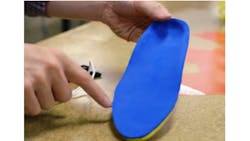Energy harvesting will move a big step forward if “SolePower,” a power-generating shoe insole becomes a commercial reality. The device is in a removable insole that you can swap between your sneakers and hiking boots.
SolePower comes in two parts: power-generating insole and battery. The user places the insole in their shoe and snakes the wire through the laces.
The battery is then fastened around the ankle or to the top of the shoe. The wire is plugged into the battery, which then receives its charge simply from the user walking. The insole is waterproof and weather-resistant. In testing, the company found that the battery would receive enough energy to fully charge an iPhone in anywhere from two-and-a-half to five miles (4 - 8km).
Specifications:
· Waterproof and weather resistant.
· Simulated to 100 million steps (i.e. you'll wear out your shoes first).
· Between 2.5 and 5 miles of walking for a full (iPhone) charge.
· Passes clinical recommendations for insole size.
The power generation design (the mechanism that fits in the insole) is working, but the electronics are still breadboarded. The ankle bracelet is a mock up, but is an accurate representation of how the final product will look and feel.
This idea started as a capstone mechanical engineering design project at Carnegie Mellon University. The designers developed a proof-of-concept prototype for lighting up shoes so students could easily see where they were walking at night, and cars could easily see the students. Then, they quickly realized that the power generation concept was more universal than small lights. By storing the charge in an external system, they could generate enough power to charge small, mobile electronics like cell phones. Thus, SolePower was born.
The biggest technical challenge was the size of the insole. They talked with local podiatrists to make sure SolePower doesn't affect the way people walk. The insoles you see in the figure are professional, custom orthotics and pass clinical recommendations.
The second challenge is large scale manufacturing. They have mentors who have scaled up electronics companies from local businesses to global players. They are working closely with them to make sure we meet our delivery goals.
It does not use piezoelectric material that produces a voltage when deformed. It’s expensive and doesn't have high power output capabilities. Their technology uses mechanical linkages and generators to capture power.
These entrepreneurs are among the finalists in several national competitions and engaged with investors who are interested in helping them reach their goals. They are involved in a Kickstarter campaign that will be a crucial part in assisting and even accelerating the process of getting our product market-ready. In addition, they know that there are people who are as excited as they are for our product.
The money they raise will go towards building the ankle bracelet and finalizing a mass producible product. The more money they raise, the faster they can get to market. They have a dedicated team from Carnegie Mellon University and UC Berkeley, so they're confident they can deliver an awesome product. They are engineers who are conservative when it comes to technology-related timelines. But they’re also entrepreneurs, so don’t be surprised if they get the product out earlier than expected.
What's Kickstarter?
Kickstarter is a funding platform for creative projects: from films, games, and music to art, design, and technology. Kickstarter is full of ambitious, innovative, and imaginative projects that are brought to life through the direct support of others.
Since its launch on April 28, 2009, over $500 million has been pledged by more than 3 million people, funding more than 35,000 creative projects.
Thousands of creative projects are funding on Kickstarter at any given moment. Each project is independently created and crafted by the person behind it. The filmmakers, musicians, artists, and designers you see on Kickstarter have complete control and responsibility over their projects. They spend weeks building their project pages, shooting their videos, and brainstorming what rewards to offer backers. When they're ready, creators launch their project and share it with their community.
Every project creator sets their project's funding goal and deadline. If people like the project, they can pledge money to make it happen. If the project succeeds in reaching its funding goal, all backers' credit cards are charged when time expires. If the project falls short, no one is charged. Funding on Kickstarter is all-or-nothing.
About the Author

Sam Davis Blog
Editor-In-Chief - Power Electronics
Sam Davis was the editor-in-chief of Power Electronics Technology magazine and website that is now part of Electronic Design. He has 18 years experience in electronic engineering design and management, six years in public relations and 25 years as a trade press editor. He holds a BSEE from Case-Western Reserve University, and did graduate work at the same school and UCLA. Sam was the editor for PCIM, the predecessor to Power Electronics Technology, from 1984 to 2004. His engineering experience includes circuit and system design for Litton Systems, Bunker-Ramo, Rocketdyne, and Clevite Corporation.. Design tasks included analog circuits, display systems, power supplies, underwater ordnance systems, and test systems. He also served as a program manager for a Litton Systems Navy program.
Sam is the author of Computer Data Displays, a book published by Prentice-Hall in the U.S. and Japan in 1969. He is also a recipient of the Jesse Neal Award for trade press editorial excellence, and has one patent for naval ship construction that simplifies electronic system integration.

